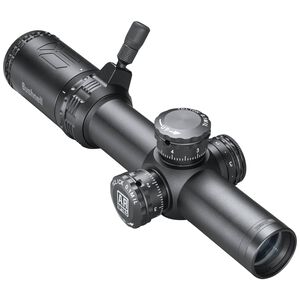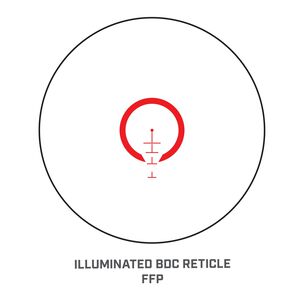Back in the old days, you would sight your target with crosshairs. Now, we use more advanced versions of this method. Terms like reticle, first (or front) focal plane, second (or rear) focal plane, and illuminated reticle are used to describe scopes, as opposed to crosshairs. This article is intended to boil all this down so you can make an informed decision about buying and using illuminated scopes.
To Understand an Illuminated Reticle, You Need to Understand a Non-Illuminated Reticle
As you look through a riflescope, the targeting aid that you see superimposed over the image is the reticle. Like many of us, you may have grown up using the term “crosshairs” rather than reticle and you might have found two wires, hairs, or threads embedded in the scope if you took one apart.
These days, the reticle is not formed from hairs, which is why the term “crosshairs” has fallen into disuse. Rather, the reticle is projected into the optical pathway with a small mirror in the scope.
The terms “first focal plane” and “second focal plane” describe where the reticle is projected. A scope has an ocular lens at the front end or the rear end that is pointed toward the target. As light passes through the ocular lens, it is focused at the first focal plane. Light continues through a set of lenses to magnify the image carried by that light. The magnified image is focused at the second focal plane and is visible through the ocular lens at the end that is pointed toward your eye.
The reticle can be projected at the first focal plane or the second focal plane. In a fixed magnification scope, the location of the reticle doesn’t make any difference in the operation of the scope. However, in a variable magnification scope, the difference in the location of the scope will make a visible difference in what you see through the scope.
The Location of the Reticle Determines Whether It Is Fixed or Magnified
When the reticle is projected at the first focal plane, it is in front of the magnification assembly (also called the erector or zoom assembly). This means that the reticle is part of the image passing through the magnifying lenses. Thus, as the image is magnified, the reticle will also be magnified.
Conversely, when the reticle is projected at the second focal plane, it is behind the magnification assembly. This means that the image is magnified before it reaches the reticle. Thus, the reticle will always be the same size regardless of whether the image is magnified.
As a result, markings on the reticle will have different visibility and usability depending on where the reticle is projected. When the reticle is fixed in size, markings are visible at all magnification levels, but the scope will need to be recalibrated at different magnification levels if the markings are used to estimate bullet drop.
On the other hand, when the reticle is magnified with the image, markings will enlarge or shrink in size as the magnification changes. Consequently, markings may disappear or move outside the field of view as the scope zooms out of, or into, the target. However, bullet drop as measured by the markings will remain constant regardless of the magnification level.
The Functioning and Use of an Illuminated Reticle Scope
An illuminated scope has internal lights to produce an illuminated reticle. This can help you pick up the reticle in adverse lighting conditions such as pre-dawn, twilight, rainy, snowy, or cloudy conditions. An illuminated reticle can also be used to provide contrast with a target darkened by its coloration or a shadow. For example, a non-illuminated reticle may be difficult to identify something like a dark brown elk standing in the shadow of a tree.
An illuminated reticle is typically lit by a small LED. In most cases, the LED is red, but some illuminated scopes use green or amber. These colors are used because they can be picked up in low light conditions but do not cause the eye’s pupil to contract as much as white light, thus preserving your natural night vision.
An illuminated scope is used the same as a non-illuminated scope. Since legal hunting hours are set by most states based on the local sunrise and sunset, hunters who want to hunt at the beginning of the day or the end of the day may benefit by using the illuminated reticle feature on an illuminated scope. The remainder of the day, you may choose to turn the illumination feature off or use it selectively based on the lighting conditions of your target.
Know When it is Legal to Use an Illuminated Scope
To be clear, an illuminated scope does not project light like a flashlight. Therefore, laws against spotlighting usually do not apply to illuminated scopes. Similarly, an illuminated scope uses neither night-vision technology to enhance ambient light nor infrared sensors to pick up heat from a target. Thus, illuminated scopes are usually deemed to be outside the reach of laws prohibiting these types of devices. Finally, illuminated scopes are not laser scopes. Therefore, laws and competition rules that prohibit laser scopes typically do not prohibit illuminated scopes.
You should always be sure to check the local regulations in the jurisdiction you plan to hunt. While many states have clarified their laws within the past few years to state that illuminated scopes are allowed, some states have not yet undertaken similar efforts. Since the use of prohibited equipment can lead to fines, confiscation of the equipment, and other penalties, it is always recommended that you review the state handbook or call the state wildlife agency before using an illuminated scope.
Use an Illuminated Reticle Scope to Improve Contrast with a Target
An illuminated scope does not improve or alter the image of the target. Rather, an illuminated scope only alters the brightness of the reticle. This can be useful in low light conditions and when the coloration or lighting of the target makes the reticle difficult to see. Thus, the key point to remember when using the illumination feature of your scope is that it provides a contrast between the reticle and the target, allowing you to place the reticle where you want it on the target.
Bushnell’s line of riflescopes includes both non-illuminated and illuminated reticles. Browse our products to find one that fits your low-light hunting and target shooting requirements.


